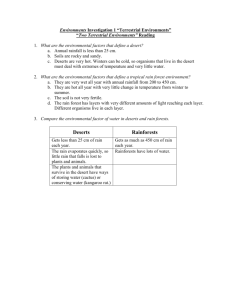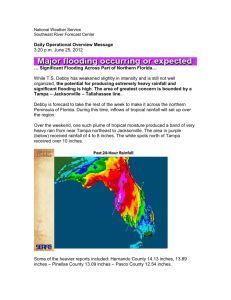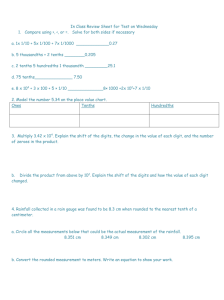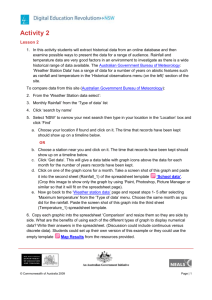Let It Rain
advertisement
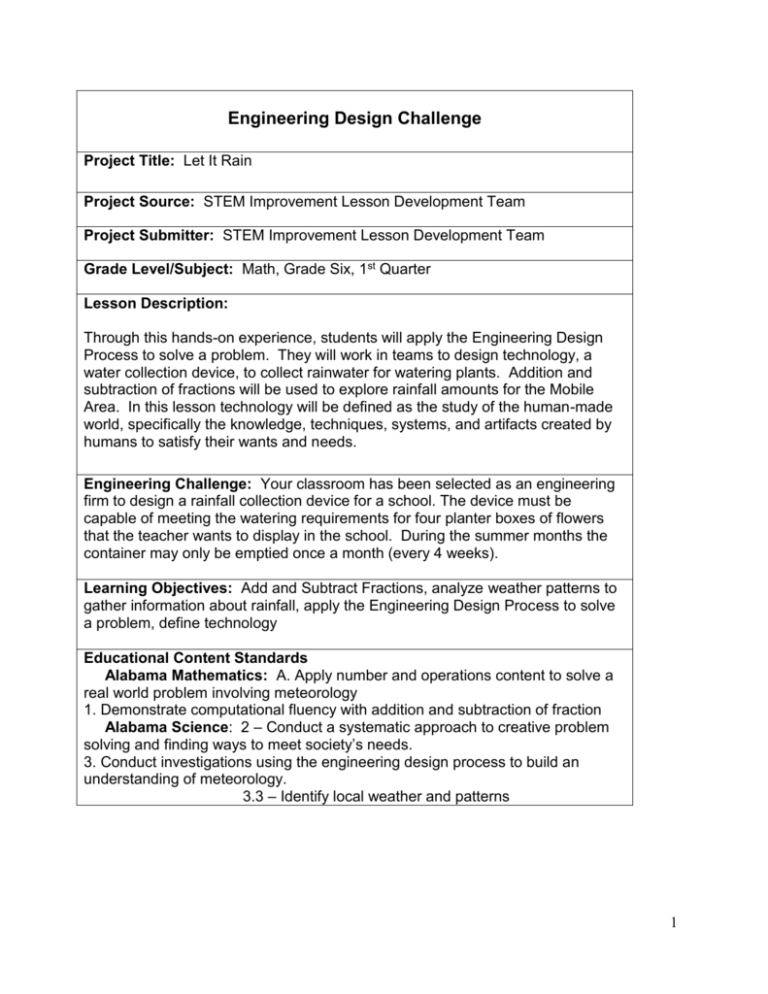
Engineering Design Challenge Project Title: Let It Rain Project Source: STEM Improvement Lesson Development Team Project Submitter: STEM Improvement Lesson Development Team Grade Level/Subject: Math, Grade Six, 1st Quarter Lesson Description: Through this hands-on experience, students will apply the Engineering Design Process to solve a problem. They will work in teams to design technology, a water collection device, to collect rainwater for watering plants. Addition and subtraction of fractions will be used to explore rainfall amounts for the Mobile Area. In this lesson technology will be defined as the study of the human-made world, specifically the knowledge, techniques, systems, and artifacts created by humans to satisfy their wants and needs. Engineering Challenge: Your classroom has been selected as an engineering firm to design a rainfall collection device for a school. The device must be capable of meeting the watering requirements for four planter boxes of flowers that the teacher wants to display in the school. During the summer months the container may only be emptied once a month (every 4 weeks). Learning Objectives: Add and Subtract Fractions, analyze weather patterns to gather information about rainfall, apply the Engineering Design Process to solve a problem, define technology Educational Content Standards Alabama Mathematics: A. Apply number and operations content to solve a real world problem involving meteorology 1. Demonstrate computational fluency with addition and subtraction of fraction Alabama Science: 2 – Conduct a systematic approach to creative problem solving and finding ways to meet society’s needs. 3. Conduct investigations using the engineering design process to build an understanding of meteorology. 3.3 – Identify local weather and patterns 1 Materials required: For each team of 3-4 students: 2-3 small plastic containers of varying sizes, 2-3 large sheets of drawing paper, markers, ruler, small dishpan to collect water, plastic measuring cup, water, 2 copies of Student Handout B For each student: 1 copy of Student Handout A 2 Let It Rain Sixth Grade Math First Quarter Day 1 Preparation: Copy Student Handouts (A – 1 per student; B – 2 per team) Assign students to teams of 3 - 4 Engage: (15 minutes) Show students a video clip of a rainfall event (TBD); Establish the need for water conservation and for protecting our natural resources. Only about 1 % of the earth’s supply of water is fresh water and can be used for drinking and other purposes. *Teacher note: Prior to teaching this unit it is recommended that you read Chapter 16 of the 6th grade science textbook for background information. Clarify the definition of technology. Have students list at least 3 examples of technology they see in the classroom. Expect answers like computers, calculators, SmartBoard, etc. Hold up a couple of objects such as a stapler, pencil, dry erase marker, a shoe or paper clip. Explain that these are examples of technology. Ask students what they think you mean when you say technology. Lead students to understand that technology is something designed by people to meet a need. For example, a bicycle is technology. It was designed to meet a need for transportation. Ask students to suggest what need they think the objects you held up were designed to meet. Tell students that we will be using the following definition of technology: Technology is defined as the study of the human-made world, specifically the knowledge, techniques, systems, and artifacts created by humans to satisfy their wants and needs. Explain that students are (or will be) studying weather in science. In math they will be looking at rainfall and ways to conserve water. 3 Ask students to list some examples of technology associated with these topics. Examples: rain gauges, thermometers, water filters, anemometers, etc. Define the Problem Your classroom has been selected as an engineering firm to design a rainfall collection device for a school. The device must be capable of meeting the watering requirements for four planter boxes of flowers that the teacher wants to display in the school. During the summer months the container may only be emptied once a month (every 4 weeks). Tell students that each planter requires 4 1/3 cups of water each week to grow and thrive. Each student design team’s task is to design a model of a water collection device that will be placed in the school yard. Each collection device must be capable of collecting enough water to meet the monthly water need of all 4 planter boxes. Research the Problem Ask: What are some things you need to know before starting this challenge? Allow students to brainstorm. Record answers on the board. Possible student responses: How much rain do we get in a week? Month? How much rain do we get in 3 months? What are some weather patterns or conditions that impact the amount of rainfall in Mobile? How big will the container have to be? How will we measure the rainfall? What materials can we use? How much water is needed for all four planters? Tell students that we do not have to know about materials right now. We will just be designing the container, not building it. The answer to some of the other questions will help us with our designs, but we will have to do some research to find the answers to them. *Teacher note: If students do not mention amounts of rainfall or weather patterns use questions to guide them in that direction. For example: Is it important for us to know about the weather in Mobile. What are some things about Mobile’s weather that we need to think about? 4 Ask: What are some other things you might need to think about when designing your containers? Possible answers: How will you get the water to the plants? How can you keep bugs and trash out of the water? What if the water evaporates? What if animals drink the water? Explain that students will get a chance to answer this type of question later. We are going to start by doing some research to find out about rainfall and the amount of water needed. Explore: Research the Problem (continued) – Divide students into teams of 3 or 4 students and distribute Student Handouts A and B. Allow the students to organize their data and plans however they decide. Do not tell them how to do this. Guide them with questions if necessary. Examples: What information do you need? Where can you get this information? What type of testing will you need to conduct? Gather Information – Students work as a team to complete Student Handout A. Student Handout B has information the students will need to be able to answer questions about rainfall in the Mobile Area. (Note: If time permits, teachers can ask other questions about information in Handout B to give students more opportunities to add, subtract and compare fractions.) Provide each team with 2 -3 different sizes of small plastic containers. Student design teams conduct experiments to determine the relationship between depth of water and quantity of water.. Use a small container to measure water amounts then scale up. (This sets the stage for the fact that the height of water can be reduced by increasing the size of the base of the collection device.) *Teacher note: If students have trouble understanding the concept of reducing the height of water needed by increasing the size of the base, tell them to think about a swimming pool. Compare what an inch of water in the swimming pool would look like to an inch of water in one of the small plastic containers. 5 Develop Solutions After completing Student Handout A, student design teams brainstorm possible designs for a rain collection device. Remind students to use the information from their research. Make sure they include the dimensions for their container. Choose a Solution – Direct student teams to choose their best possible design. Have them justify their choice. Create a Model – Explain that engineers use models to help them share their designs with others. Sometimes they use 3-dimensional models to build a prototype. They also use drawings or blueprints to explain their designs. Tell student design teams that they will draw a sketch of their selected design to show to the class. Make sure they label the dimensions of their designs. (Designs do not have to be drawn to scale.) If some teams finish early encourage them to think about solutions to some of the problems mentioned earlier and add features to their designs that might solve those problems. For example, to keep animals from drinking the water they might design a cover that will let the rain it, but keep animals out. Explain: Communicate - Teams present their designs to the class. - Give the students 5 minutes to organize their presentation - Each team should select one team member to make the presentation for the team with the final design - Each group should keep their presentation brief and to the point Extend: Redesign After all teams have presented their design lead a discussion of the advantages and disadvantages of each design. Encourage behaviors that will build a climate of respect in the classroom. Allow a few minutes for teams to meet and discuss some features they would like to consider changing or adding to their design that would make it better. Ask students to describe what they did to solve the problem. Relate their responses to the Engineering Design Process 6 7 Let It Rain Student Handout A Design a Rain Collection Device for Your Schoolyard You are working as a team of engineers who have been given the challenge to design a rain water collection device for your school yard. The rain collected in this device will be used to care for flower plants at the school. There will be 4 flower planter boxes. Each planter will need 4 1/3 cups of water every week. The collection devices must be capable of collecting enough water to meet the monthly water need of all 4 planter boxes. Your team must examine local rainfall patterns to determine how large a collection device is required and draw a sketch of your design. You will need to do some math calculations so that you can compare and contrast typical monthly rainfall amounts and also to relate the depth of water collected to the amount or water required. Work with your team to answer the following questions. PART A: 1. What is the total amount of rain you will need for one week? ________, For one month? ____________ 2. How much rain will be needed for all four planters for the summer (June, July and August)? ________ Explain your answers: ___________________________________________________________________ ___________________________________________________________________ Part B: Review the rainfall data for Mobile’s regional airport to answer the following questions. 1. What was the total rainfall for the Summer (June, July and August) of 2010? 2. In 2010, what was the minimum (smallest amount) and maximum (largest amount) of rainfall? 3. What was the 50 year average for rainfall during June, July and August? 8 4. What are the minimum and maximum rainfall amounts for the 50 year average? 5. How does the total amount of rainfall for 2010 compare to the 50 year average? 6. What is the difference in the amount of rainfall in July of 2010 compared to the 50 year average for July? What might have caused the difference? 7. Is there other information that you need to know before designing your collection device? PART C: Analyze the rainfall data to determine how large your rainfall collector needs to be. Conduct any necessary experiments to determine how large your rainfall collection device needs to be. Design and sketch your collection device. 1. As a team, develop and agree on a design for the rain collection device 2. Make a sketch of your selected rain collection design. Your sketch must show all dimensions and include a scale for measuring the depth of water. 3. Determine the depth of rainwater that must be collected in your design to meet the watering requirements specified by your teacher. Part D: Communicate your results. 1. Prepare a presentation on the results of your design. Select one team member to make the presentation to the entire class. 2. Evaluate design presentations by all teams and select the best design from the entire class Student Handout B 9 Rainfall Data for Mobile Area 50 year average (inches) Mobile Area 2010 actual (inches) Mobile Area Month Jan 5 3 1/2 Feb 5 1/4 4 7/8 Mar 6 5/8 4 Apr 5 1/4 1 3/4 May 5 5/8 8 7/8 Jun 5 1/4 3 3/8 Jul 7 1/2 4 3/8 Aug 6 7/8 7 1/4 Sep 5 3/4 2 Oct 3 4 1/8 Nov 4 1/4 6 Dec 5 3/8 1 3/8 10 Let It Rain Student Handout C Draw and label a sketch of your team’s design. 11





